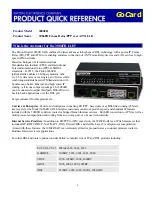
Cisco 7000 and Cisco 7507 Chassis Replacement Instructions 9
Prerequisites
Safety with Electricity
Follow these basic guidelines when working with any electrical equipment:
•
Before beginning any procedures, locate the emergency power-off switch for the room in which
you are working.
•
Never assume that power has been disconnected from a circuit; always check.
•
Always disconnect all cables (including network interface and telephone wiring) and remove all
power supplies before moving or lifting the chassis.
Warning
Always disconnect all cables before moving or working on the chassis. Even when the
chassis is disconnected from all power sources, telephone wiring can still deliver potentially lethal
electrical surges.
•
Never install telephone wiring during a lightning storm.
Warning
Do not work on the system or connect or disconnect cables during periods of lightning
activity. (For translations of this safety warning, refer to the section “Lightning Activity Warning”
on page 41.)
•
Never install telephone jacks in wet locations unless the jack is specifically designed for wet
locations.
•
Never touch uninsulated telephone wires or terminals unless the telephone line has been
disconnected at the network interface.
•
Use caution when installing or modifying telephone lines.
Cable Strain Relief
If possible, position the new replacement chassis close enough to the existing system so that you can
avoid having to disconnect power and interface cables. Be sure to disengage any strain relief devices
before attempting to pull the cables from the port. Following are descriptions of the different
methods of strain relief that are used on the power supplies and the various types of network interface
ports:
•
On the AC-input power supplies, a cable retention clip snaps up around the connector on the
power cord to prevent it from being inadvertently pulled out of the power supply port. Before
attempting to disconnect the power cord, be sure to push the retention clip down away from the
cable connector.
•
On the DC-input power supplies, two nylon cable ties provide strain relief for the DC-input
cables.
•
Serial interface cables (all types) use thumbscrews on the cable connectors that secure the cable
to the FSIP port.
•
Ethernet interface cables use either slide-type locks or thumbscrews. The Ethernet Interface
Processor (EIP) ports are shipped from the factory with slide-type locks on each port; however,
a conversion kit is also shipped for replacing the slide-type locks with jackscrews to
accommodate Ethernet interface cables with thumbscrews.










































